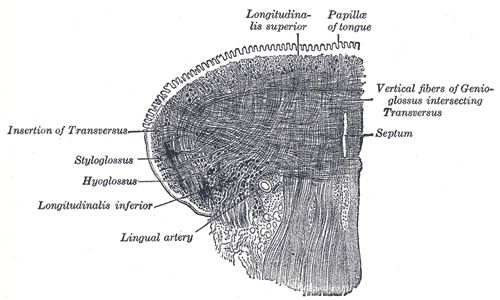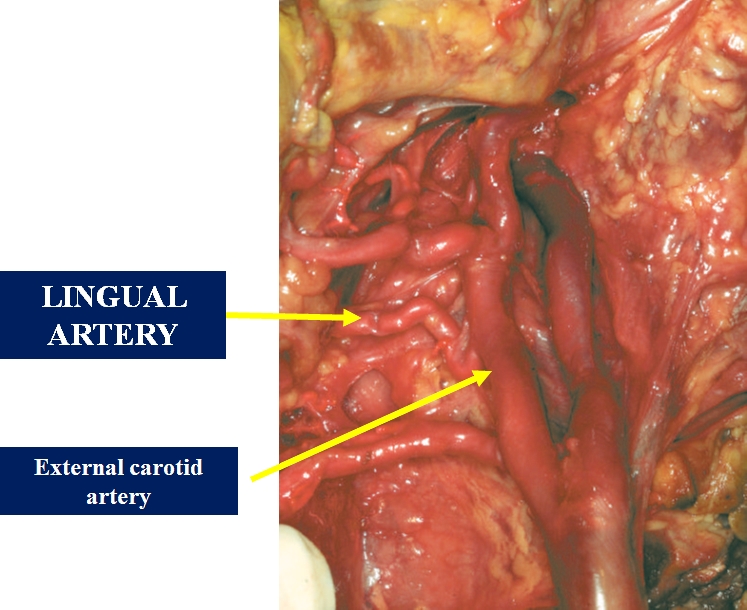[1]
Buffoli B, Verzeletti V, Rezzani R, Rodella LF. Unusual branch of the lingual artery supplies the infrahyoid muscles. Anatomical science international. 2020 Jan:95(1):153-155. doi: 10.1007/s12565-019-00501-6. Epub 2019 Aug 23
[PubMed PMID: 31444702]
[2]
Sakamoto Y. Gross anatomical observations of attachments of the middle pharyngeal constrictor. Clinical anatomy (New York, N.Y.). 2014 May:27(4):603-9. doi: 10.1002/ca.22344. Epub 2013 Dec 17
[PubMed PMID: 24343865]
[3]
Seki S, Sumida K, Yamashita K, Baba O, Kitamura S. Gross anatomical classification of the courses of the human lingual artery. Surgical and radiologic anatomy : SRA. 2017 Feb:39(2):195-203. doi: 10.1007/s00276-016-1696-8. Epub 2016 May 17
[PubMed PMID: 27189234]
[4]
McDonnell D, Reza Nouri M, Todd ME. The mandibular lingual foramen: a consistent arterial foramen in the middle of the mandible. Journal of anatomy. 1994 Apr:184 ( Pt 2)(Pt 2):363-9
[PubMed PMID: 8014127]
[5]
Singh M, Vashistha A, Chaudhary M, Kaur G. Forgotten triangles of neck. Annals of maxillofacial surgery. 2016 Jan-Jun:6(1):91-3. doi: 10.4103/2231-0746.186149. Epub
[PubMed PMID: 27563614]
[6]
Kikuta S, Iwanaga J, Kusukawa J, Tubbs RS. Triangles of the neck: a review with clinical/surgical applications. Anatomy & cell biology. 2019 Jun:52(2):120-127. doi: 10.5115/acb.2019.52.2.120. Epub 2019 Jun 30
[PubMed PMID: 31338227]
[7]
Meegalla N, Sood G, Nessel TA, Downs BW. Anatomy, Head and Neck: Facial Arteries. StatPearls. 2023 Jan:():
[PubMed PMID: 30725617]
[8]
Iaconetta G, Solari D, Villa A, Castaldo C, Gerardi RM, Califano G, Montagnani S, Cappabianca P. The Hypoglossal Nerve: Anatomical Study of Its Entire Course. World neurosurgery. 2018 Jan:109():e486-e492. doi: 10.1016/j.wneu.2017.10.006. Epub 2017 Oct 12
[PubMed PMID: 29032218]
[9]
Yu JL, Thaler ER. Hypoglossal Nerve (Cranial Nerve XII) Stimulation. Otolaryngologic clinics of North America. 2020 Feb:53(1):157-169. doi: 10.1016/j.otc.2019.09.010. Epub 2019 Nov 4
[PubMed PMID: 31699408]
[10]
Lauretano AM, Li KK, Caradonna DS, Khosta RK, Fried MP. Anatomic location of the tongue base neurovascular bundle. The Laryngoscope. 1997 Aug:107(8):1057-9
[PubMed PMID: 9261008]
[12]
Cohen DS, Low GM, Melkane AE, Mutchnick SA, Waxman JA, Patel S, Shkoukani MA, Lin HS. Establishing a danger zone: An anatomic study of the lingual artery in base of tongue surgery. The Laryngoscope. 2017 Jan:127(1):110-115. doi: 10.1002/lary.26048. Epub 2016 May 30
[PubMed PMID: 27238879]
[13]
Mun MJ, Lee CH, Lee BJ, Lee JC, Jang JY, Jung SH, Wang SG. Histopathologic Evaluations of the Lingual Artery in Healthy Tongue of Adult Cadaver. Clinical and experimental otorhinolaryngology. 2016 Sep:9(3):257-62. doi: 10.21053/ceo.2015.01137. Epub 2016 Jun 18
[PubMed PMID: 27334510]
[14]
Holtz F, Monnier Y, Borner U, Nisa L. Bilateral lingual artery stenosis: A rare, late complication of chemoradiotherapy. European annals of otorhinolaryngology, head and neck diseases. 2017 Sep:134(4):269-271. doi: 10.1016/j.anorl.2017.02.002. Epub 2017 Mar 11
[PubMed PMID: 28291634]
[15]
Sumita K, Karakama J, Makita I, Miki K, Yoshino Y, Yoshimura M, Maehara T, Nemoto S. [A Case of Pseudoaneurysm of the Lingual Artery that was Difficult to be Distinguished from Epistaxis]. No shinkei geka. Neurological surgery. 2018 Oct:46(10):911-916. doi: 10.11477/mf.1436203838. Epub
[PubMed PMID: 30369494]
Level 3 (low-level) evidence
[16]
Mei J, Liu Y, Zhao H, Liu B, Xu S, Wu JF. [The study of clinical anatomy of lingual artery in physiological condition]. Lin chuang er bi yan hou tou jing wai ke za zhi = Journal of clinical otorhinolaryngology, head, and neck surgery. 2007 May:21(9):396-9
[PubMed PMID: 17634021]
[17]
Sobrinho RABS, de Lima KCA, Moura HC, Araújo MM, de Assis CMRB, Gouveia PADC. Tongue Necrosis Secondary to Giant Cell Arteritis: A Case Report and Literature Review. Case reports in medicine. 2017:2017():6327437. doi: 10.1155/2017/6327437. Epub 2017 Mar 23
[PubMed PMID: 28424735]
Level 3 (low-level) evidence
[18]
VanDeCappelle C, Wong J, Buchanan IM, Korman B, Ricci C. Life-threatening lingual artery hemorrhage after cardiac surgery. Canadian journal of anaesthesia = Journal canadien d'anesthesie. 2017 Mar:64(3):333-334. doi: 10.1007/s12630-016-0770-3. Epub 2016 Nov 2
[PubMed PMID: 27807705]
[19]
Li ZP, Meng J, Wu HJ, Zhang J, Gu QP. [Application of superselective lingual artery embolization in treatment of severe hemorrhange in patients with carcinoma of tongue]. Zhonghua kou qiang yi xue za zhi = Zhonghua kouqiang yixue zazhi = Chinese journal of stomatology. 2018 Jun 9:53(6):425-427. doi: 10.3760/cma.j.issn.1002-0098.2018.06.012. Epub
[PubMed PMID: 29886639]
Level 2 (mid-level) evidence
[20]
Margallo L, Zárate EO, Franco M, Garcia-Iruretagoyena M, Cherro R, Barbier L, Mendiola J, Constantinescu T. Lingual Artery Pseudoaneurysm after Severe Facial Trauma. Craniomaxillofacial trauma & reconstruction. 2018 Sep:11(3):219-223. doi: 10.1055/s-0037-1603454. Epub 2017 May 18
[PubMed PMID: 30087752]



